Google Wifi review: The easiest networking system you will ever use
Note: This article was first published on 30th September 2017.
It’s finally here, but...
“When will Google Wifi be available here?” is a question that we are often asked. Released in December last year, Google marketed the Google Wifi as a simple to use, effective, and smart mesh networking system. It also received largely positive reviews, leading to high demand here. It is finally here, but there’s a catch - it is exclusive to StarHub. For now, at least. Therefore, readers contracted with other ISPs are out of luck at the moment, but there seems to be a good chance that this is only a timed exclusive and that Google Wifi will soon be available through other ISPs and even on the open market as a standalone purchase.
Before we begin the review, if you are still scratching your head and unsure about "mesh networking", we suggest reading our beginner’s guide to mesh networking first. With that out of the way, let’s dive right into the review.
Introducing Google Wifi
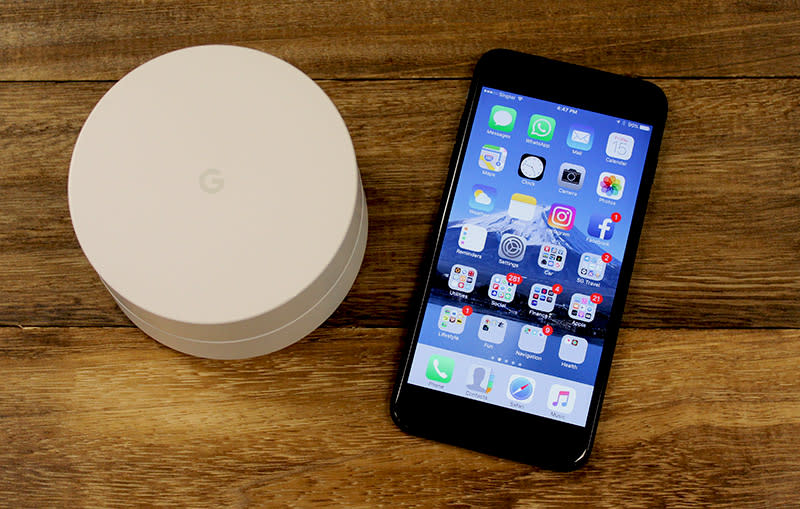
Google sells the Wifi as a standalone router or as a three-pack in the US. However, you can only get it as a 3-pack bundle here in Singapore. That’s not a big issue since what’s the point of a mesh networking system if you only have a single node?
The first thing about the Google Wifi that strikes you is their size. They are incredibly small. Compared to behemoths like the ASUS ROG Rapture GT-AC5300, the Google Wifi is positively tiny.
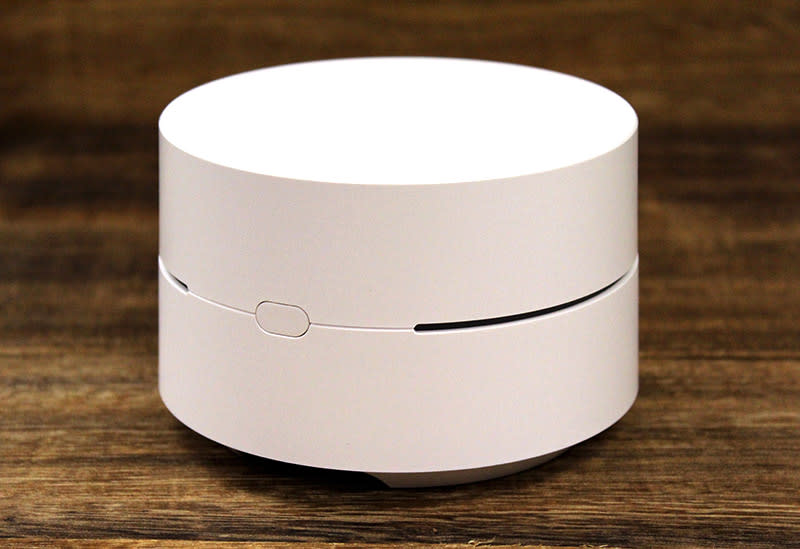
Each node is a tiny cylinder and very identical to each other. Each measures 10.6cm across and stands at about 6.8cm tall. This is much smaller than even the recently launched ASUS Lyra - check this for size. In terms of appearances, Google Wifi chassis is white and made out of high-quality plastic. In other words, the Google Wifi is super compact and it looks simple but sleek. A ring of LED light that runs through the middle of each node and it acts as a handy status indicator. A solid teal light means all is well while red pulsing red light means something is wrong. There are no points for wall-mounting, but looking at how small they are, you might be able to get away with strong double-sided tape.
Underneath the router, users will find two Gigabit Ethernet ports, which can operate in both WAN and LAN modes and can be used to connect to devices like your PC, gaming consoles, or TV set-top box. Power is delivered through the USB Type-C port.
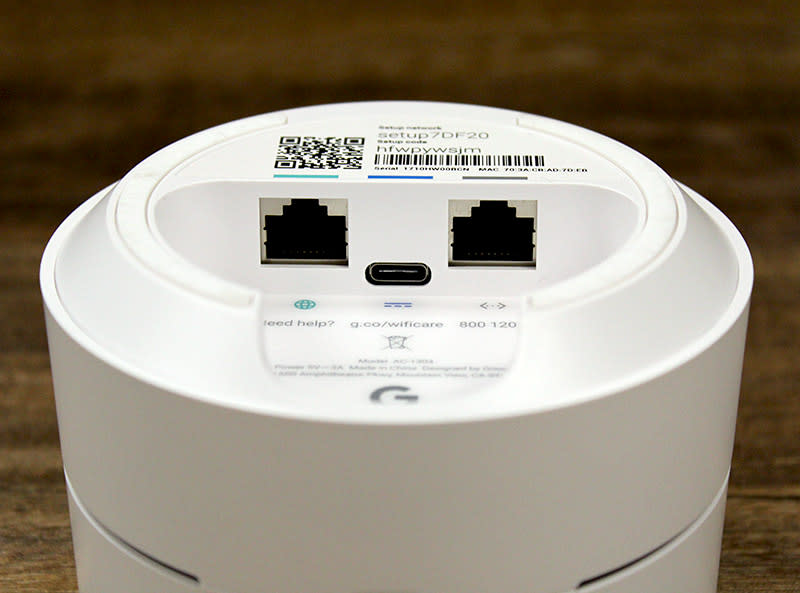
Under the hood
Time to get technical. The Google Wifi is classified as an AC1200-class dual-band wireless device. This means supported data transfer rates of 300Mbps on its 2.4GHz network and 867Mbps on its 5GHz network. It might not sound like much, but it is actually quite sufficient for the majority of devices we use today. Remember, only a tiny handful of devices can actually support speeds of above 867Mbps.
However, because it is a dual-band device it means that the Google Wifi does not have a dedicated network for backhaul communication. This could potentially have a negative impact on performance, especially if you have many connected devices as client devices have to compete with other nodes for bandwidth.
Inside each Google Wifi node is a quad-core Qualcomm IPQ4019 processor, which is identical to the Linksys Velop and ASUS Lyra. It runs at 717MHz and is complemented by 512MB of RAM and a generous 4GB of flash memory. The IPQ4019 processor’s two 2x2 radios are responsible for broadcasting both 2.4GHz and 5GHz networks.
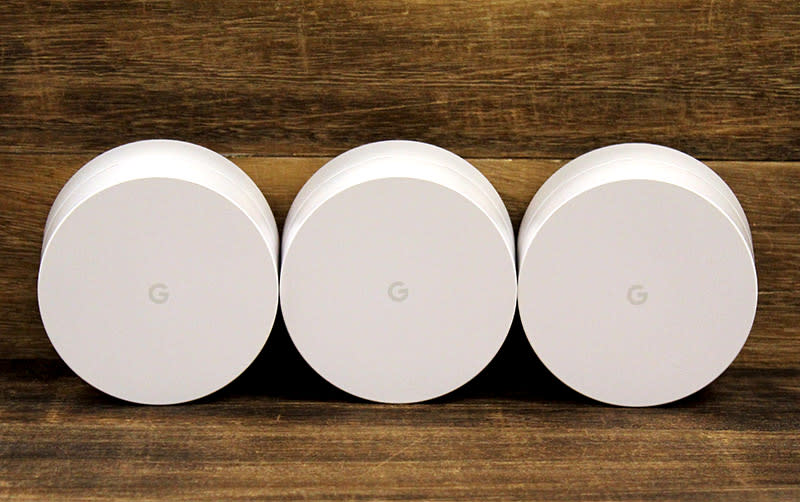
According to Google, each node is capable of covering about 900 square feet (84m2), which is sufficient only for smaller homes. Two nodes are good for 900 to 1800 square feet (84 to 167m2). This is good enough for most single story homes in Singapore. Three nodes can cover 1800 to 2700 square feet (or about 167 - 251m2). Google also says that a maximum of 14 nodes can be used, which is more than any other mesh networking system we've come across to-date. Live in a castle? Google has got you covered.
Setup & User Interface

Mesh networking systems are designed with mainstream users in mind and are generally easy to setup and Google Wifi is no different. In fact, it could very well be the easiest router we have ever setup.
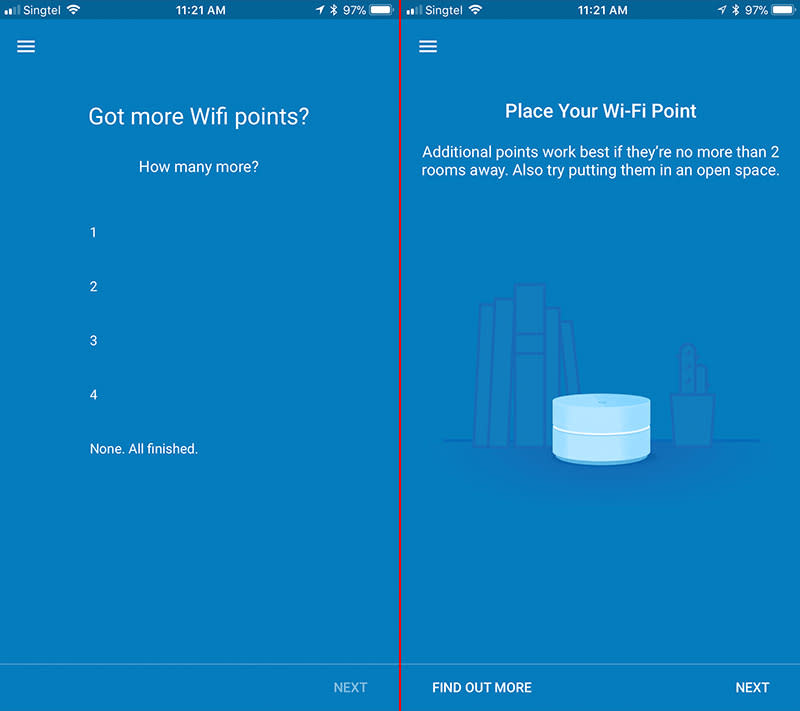
To setup Google Wifi, simply download the Google Wifi app that is available for free on Google Play and the App Store. Thereafter, simply power up your Google Wifi unit, connect it to your modem, fire up the app and follow the instructions. If it all goes smoothly, you can have the Google Wifi setup within 5 minutes. Adding extra Google Wifi nodes to create a mesh network is easy too. Again, just use the Google Wifi app.
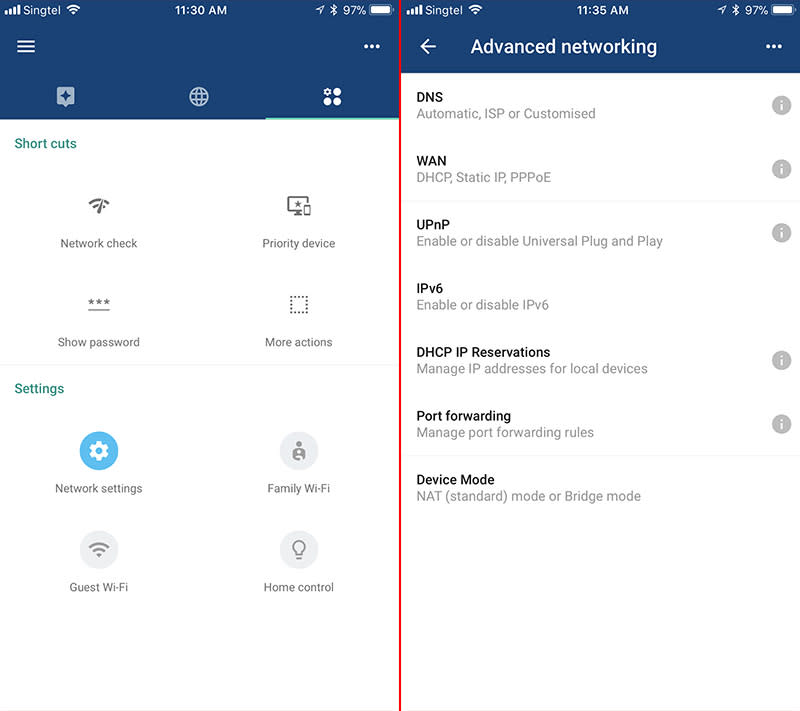
While Google Wifi is easy to use, tech-savvy users might find customization options to be very basic. There’s no traditional web setup interface and everything is done and managed using the Google Wifi app. There used to be really limited customization options, but it seems like Google has improved things with firmware updates. You have the usual guest network and parental controls, but there's also device prioritization, port forwarding, and the ability to tweak DNS settings. Perhaps the most glaring omission is the ability to manually assign devices to the 2.4GHz and 5GHz networks, and the lack of support for VPN and Dynamic DNS. That said, these options should be sufficient for most basic users.
That said, power users can still take advantage of Google Wifi’s mesh Wi-Fi capabilities by pairing it with their existing feature-packed high-end routers by using Google Wifi solely for broadcasting Wi-Fi. This way, you get all the nice features of your high-end router and the expanded Wi-Fi coverage of Google Wifi. Admittedly, this workaround is cumbersome and you end up with two Wi-Fi networks, but at least you get a wide Wi-Fi network and you retain features like support for Dynamic DNS and VPN.
Test Setup
To test these new breed of mesh networking systems, we are changing our test environment, but our test setup remains relatively unchanged. We have two notebooks, one acting as a host machine and the other as a client device. The router, or in this case, node, acts as a gateway. Since mesh networking systems typically manage channel settings on their own, we will leave it that way. For systems where manual settings are possible, a channel bandwidth of 40MHz is selected where applicable, while 80MHz or more is used for the 5GHz AC band.
The client device is a 2015 13-inch MacBook Pro, which is one of the few client devices in the market to come with a 3x3 Wi-Fi receiver, allowing it to achieve wireless speeds of up to 1,300Mbps.

To evaluate, we will be measuring the time and calculating the speed achieved when transferring a 1GB zip file. We will do multiple tests with different setups and different distances to simulate use around a typical single story flat and in a multi-story home.
Here are the test distances we used and what they represent:
2m - Right beside the router
5m - In an adjacent room
10m - In a room that is farther away
15m - To simulate extreme distances (e.g. master bedroom toilet)
Second story - One floor above
Third story - Two floors above
Here are the different Google Wifi setups we used:
A single Google Wifi router
Two Google Wifi nodes over a single floor
Three Google Wifi nodes over three floors
To further clarify, in tests where nodes were placed on the second or third floor, the measurement would be taken with the client device about two meters away from the node.
Single node performance
In this test, we will be looking at the performance of a single Google Wifi node in a single-story (using the differnt distance markers) and multi-story home. All other competitive mesh networking system results are also that of a single node setup.


The performance of a single Google Wifi node was quite disappointing. At 2 meters, the Google Wifi was very fast, capable of challenging even the likes of the Linksys EA9500. But as we moved further away, performance started dropping significantly. At 10 meters, for instance, we noticed that we were assigned to the slower 2.4GHz network and speeds were only a fraction of what we had achieved at 2 meters. Needless to say, we couldn’t get a decent connection at all at 15 meters or from other floors.
Mesh performance at 15 meters
In this test, we placed a second Google Wifi node in between the first node and the 15-meter mark to create a mesh network to get signal to the problematic 15-meter mark. We did the same for other mesh networks to see how their performance would compare.


With a second Google Wifi node in between the first node and the problematic 15-meter spot, we were finally able to get a decent connection. Overall performance is nothing shout about as it was only about half of what the Linksys Velop and Portal Wifi systems could accomplish. Nevertheless, it was still very usable and we were able to comfortably stream high-res YouTube videos - even 4K ones!
Mesh performance on 2nd floor
In this test, we placed a second Google Wifi node on the second floor and created a mesh network to expand Wi-Fi coverage on the second floor. We did the same for the other mesh networks to see how their performance would compare.


With two Google Wifi nodes in place spread across two floors, we were able to get pretty good speeds on the second floor. Download speeds were the highest we have recorded at 267.11Mbps. However, upload speeds were quite disappointing at just 137.41Mbps. Its rivals like the Linksys Velop and Portal Wifi systems were definitely much more consistent. That said, the Google Wifi’s overall performance was better than the AirTies Air 4920.
Mesh performance on 3rd floor
In this test, we placed a third Google Wifi node on the third floor to expand coverage to three floors. We did the same for other mesh networks to see how their performance would compare. However, do note that the Portal and Single AirTies setups only consist of two nodes, with one node on the first floor and the second node on the second floor.


With three Google Wifi nodes in place, we were able to expand Wi-Fi coverage to three floors. The Google Wifi’s performance here was a bit of a mixed bag. Amongst all the mesh systems, it recorded the lowest download speeds, but its upload speeds were quite decent. If anything, we would say that its performance at this range is more consistent than its rivals as it managed about 70-ish Mbps overall. Only the Linksys Velop was more consistent. In the real world, we found that these speeds were sufficient to stream high-res 4K videos from YouTube. In other words, it should be good enough for most web browsing and video streaming applications.
Excellent for some users
For advanced users who are more concerned about features and performance, the Google Wifi is probably too much of a compromise. It might be really easy to setup and use, but certain features are sorely missing, like the lack of VPN support and the ability to assign devices to its 2.4GHz and 5GHz networks.
Performance isn’t its strong suit either. It is good enough for web browsing and high-res video streaming, but users who demand more and want to share files wirelessly or backup their systems wirelessly should look elsewhere. And even though it does seem to work quite well in expanding Wi-Fi coverage, one thing to note is that the range of each individual node is quite limited. As our single node performance charts show, performance starts to dip drastically once you go past 5 meters. What this means is that even though Wi-Fi coverage is expanded, the extent to which it is expanded can be quite limited. Obviously, this depends very much on your home layout and environment, but it is worth keeping this thought in mind.
If you really want a mesh networking system, but don't want to sacrifice on performance, the Linksys Velop seems like a better and more consistent performer, albeit it's a much more pricey option. If you can do with just two nodes, the recently reviewed Portal Wi-Fi router is good too.

Nevertheless, Google Wifi does have its strong suits. Most importantly, it is incredibly easy to use and fast to set up. Even the most clueless of users can get a mesh network up and running in less than 10 minutes. For users who are not too concerned about performance, and don’t want to fuss around and meddle with networking settings, Google Wifi is ideal. It truly is a fuss-free way to expand Wi-Fi coverage around the house.
The other advantage is price. Though Google Wifi is only available through Starhub and to Starhub users for now, a three-pack Google Wifi kit (not sold separately at the moment) is just S$360. This makes it significantly more affordable than rivals like the Linksys Velop (S$749 for a three-pack kit) and ASUS Lyra (S$659 for a three-pack kit).
In closing, Google Wifi is a neat Wi-Fi mesh networking system that is great, if not superb for casual users whose main priorty is to have Wi-Fi coverage around the house. For users with more specific or demanding needs, it is better that you look elsewhere.



